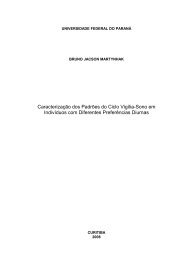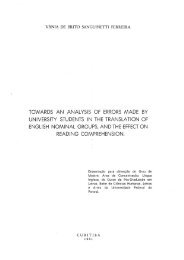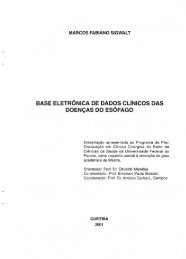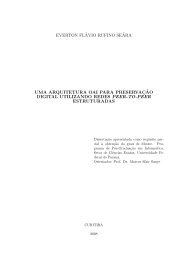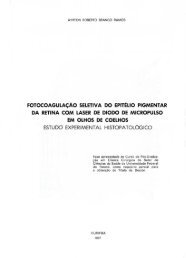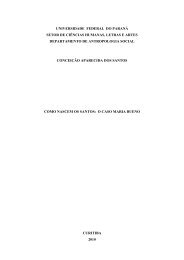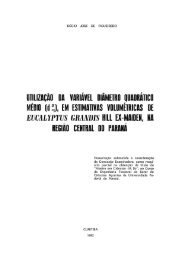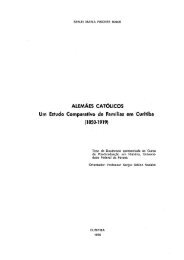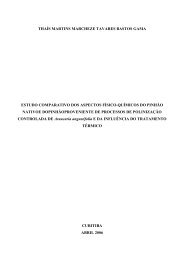identificação e manejo de nematóides da bananeira - Universidade ...
identificação e manejo de nematóides da bananeira - Universidade ...
identificação e manejo de nematóides da bananeira - Universidade ...
Create successful ePaper yourself
Turn your PDF publications into a flip-book with our unique Google optimized e-Paper software.
ABSTRACT<br />
Banana is the main fruit produced in the world. In Brazil, is the second fruit more<br />
produced, after oranges. In the same way, after oranges, is the most produced fruit in<br />
the Paraná State. In the world, nemato<strong>de</strong>s of the genus Radopholus, Helicotylenchus,<br />
Pratylenchus and Meloidogyne are among the mainly pests that attack banana trees,<br />
causing average losses of 19,7%. In Brazil those genera also occur, causing losses to<br />
banana production until 100%. In the other hand, reserches have been produced many<br />
information to manage nemato<strong>de</strong>s. In the Paraná State, near 10 thousand ha are grown<br />
with bananas from which 5,6 thousand are grown in municipalities of the coastal<br />
region. In this region, there is a lack of information about plant parasitic nemato<strong>de</strong>s<br />
related to bananas and <strong>da</strong>ted from the 80’s, when nemato<strong>de</strong>s belonged to the genera<br />
Helicotylenchus and Meloidogyne were i<strong>de</strong>ntified. However, there is a suspect that<br />
other nemato<strong>de</strong>s are already present, because nemato<strong>de</strong> prevention practices are not<br />
adopted. This present study had the objective to produce information about the<br />
occurrence of nemato<strong>de</strong>s associated to bananas (Musa spp.) and about the manage<br />
practices used by the producers, in five municipalities of the coastal region of the<br />
State. During smptember/2005 and april of 2006, 114 samples of soil and banana roots<br />
were processed and 48 producers were interviewed. Samples analysis reveled the<br />
presence of 13 genera of nemato<strong>de</strong>s. Helicotylenchus, Radopholus, Meloidogyne,<br />
Pratylenchus, Tylenchus, Mesocriconema and Discocriconemella were present in soil<br />
and roots samples. Rotylenchulus, Xiphinema, Aphelenchus, Trichodorus,<br />
Hemicycliophora and Scutellonema were present only in soli samples.<br />
Helicotylenchus, Radopholus and Meloidogyne were <strong>de</strong>tected in all municipalities at<br />
the following absolute frequencies in the roots: 93%, 68%, 59%, respectively.<br />
Pratylenchus was more concentrate, at 37% of samples, and was not present in São<br />
José dos Pinhais, although had been the most frequent nemato<strong>de</strong> in Guaratuba (78%).<br />
Radopholus similis show highest average <strong>de</strong>nsities and (5.480 nemato<strong>de</strong>s/100 g)<br />
maximum (139.000/100 g); followed by Helicotylenchus (4.530/100 g e 40.080/100<br />
g), Pratylenchus (2.860/100 g e 57.600/100g) and Meloidogyne (710/100 g e<br />
6.520/100 g). Thirty six per cent of samples showed total nemato<strong>de</strong> <strong>de</strong>nsities above of<br />
10.000 nemato<strong>de</strong>s/100 g of roots, consi<strong>de</strong>red how the critical level in other countries.<br />
In general, farmers don’t adopt practices to prevention and control nemato<strong>de</strong>s and this<br />
was the fisrt time that nematological analysis were processed. The produced<br />
information is fun<strong>da</strong>mental to stimulate nemato<strong>de</strong> manage in the reaactions towards to<br />
manage nemato<strong>de</strong>s in the region.<br />
Key-words: Banana; Musa spp.; Nemato<strong>de</strong>s; Helicotylenchus; Meloidogyne;<br />
Radopholus; Pratylenchus; survey.<br />
xi



